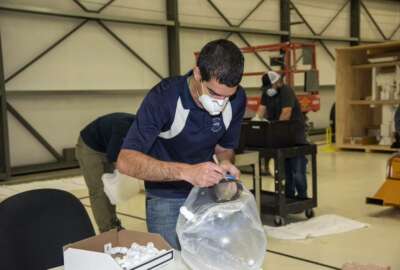NASA crowdsourcing initiative sparks more than 200 employee-driven ideas to fight coronavirus
NASA employees submitted more than 200 ideas to an agency-led crowdsourcing initiative designed to solicit coronavirus response solutions. A few of the ideas,...
Best listening experience is on Chrome, Firefox or Safari. Subscribe to Federal Drive’s daily audio interviews on Apple Podcasts or PodcastOne.
Ask the NASA workforce to stay home and it’s not long before its engineers, developers and other scientists are looking for ways their organization can help during the coronavirus pandemic.
It’s why NASA, after an outpouring from the workforce, relaunched an employee crowdsourcing initiative to solicit new ideas on ways the agency could respond to the pandemic.
“NASA’s workforce is all about solving problems,” Cathy Mangum, NASA’s deputy associate administrator, said in an interview with Federal News Network. “We have extremely intelligent engineers and passionate people who really wanted to help, and it was truly coming up as almost a rise out of the workforce of, ‘Hey, how can we help?'”
The initiative, called “NASA@Work,” has been used before to gather employee ideas for other challenges. The agency has previously solicited design ideas for astronaut-friendly waste receptacles in space, as well as solutions that could enable small missions to survive on the Moon’s surface during extreme temperature changes.
Employees began submitting ideas April 1. They sent in more than 200 ideas to NASA’s internal crowdsourcing platform, a response that far outpaced past “NASA@Work” challenges, Mangum said.
For this particular “NASA@Work” call, Administrator Jim Bridenstine challenged the workforce to focus on providing personal protective equipment, developing new ventilation devices and using big data to monitor and track the spread of coronavirus,
A team of NASA leaders reviewed the ideas and determined how the agency could scale and expand them, and more than 4,000 employees voted and commented on the submissions, Mangum said.
First, NASA is exploring whether previously-developed decontamination systems can be used to sanitize everyday surfaces that could be exposed to coronavirus.
“When we’re preparing hardware to go to space it has to be absolutely clean. We don’t want to introduce anything into the destinations we’re going to,” Mangum said. “Over time it’s really evolved. Now we’re looking at how can we decontaminate not only medical masks and the ventilators and things like that, but how can we decontaminate surfaces, so people maybe could feel better about going back to work?”
Engineers at NASA’s Jet Propulsion Laboratory in California have designed a new ventilator specifically for coronavirus patients with milder symptoms, NASA said. The Ventilator Intervention Technology Accessible Locally (VITAL) already passed testing in New York, and the Food and Drug Administration is reviewing it for emergency-use authorization.
NASA’s Armstrong Flight Research Center in California also worked with a variety of partners to build an oxygen helmet for coronavirus patients with mild symptoms. The goal, according to the agency, is to minimize the need for these patients to use a full-fledged ventilator.
The device, otherwise known as the Aerospace Valley Positive Pressure Helmet, also passed its first test at a hospital last week and is under FDA review.
In addition, NASA is exploring the prospects of a kind of breathalyzer device, which Mangum said could be used to quickly test for coronavirus itself or covid antibodies.
“Some of these are pretty early in the maturity cycle, but we’ve gotten some ideas about how we take the technology we have at NASA and apply it to this problem,” she said.
Bridenstine and NASA officials demonstrated many of these ideas to President Donald Trump at the White House on Friday.
NASA is working with the Department of Homeland Security, as well as the State Department, U.S. Agency for International Development and the White House to discuss the ideas and find ways they can collaborate. NASA’s contractors and small business partners are also part of the conversation, Mangum said.
“There is this sense of urgency to solve the immediate crisis,” she said. “We’re trying to push hard on a couple of these that might help with the come back strategy. Some of these might be a little longer-term. We often at NASA think about things that involve long-term research and what are we going to need in 10-20 years? We’re not really doing that, but we’re looking at probably a six-month horizon.”
Beyond the successful crowdsourcing initiative, NASA officials have been hosting virtual townhall meetings to keep the workforce engaged.
About 90% of the workforce is teleworking, a move that NASA made within one-to-two weeks, Mangum said. Employees were relatively accustomed to telework, and most already had laptops, she said.
Bridenstine has popped in and out of virtual meetings with small groups of NASA employees, and NASA leadership has been sharing advice with its supervisors on virtual management techniques, Mangum said.
Astronauts with their personal experience in social isolation techniques have reached out to the NASA workforce to share their own advice, Mangum said.
“From day one the focus has been about the employees,” she said. “We talk a lot about the NASA family. Our number one focus was that our employees — and that’s all employees, not just civil servants but our contractors who support us — were safe.”
Copyright © 2025 Federal News Network. All rights reserved. This website is not intended for users located within the European Economic Area.
Nicole Ogrysko is a reporter for Federal News Network focusing on the federal workforce and federal pay and benefits.
Follow @nogryskoWFED




